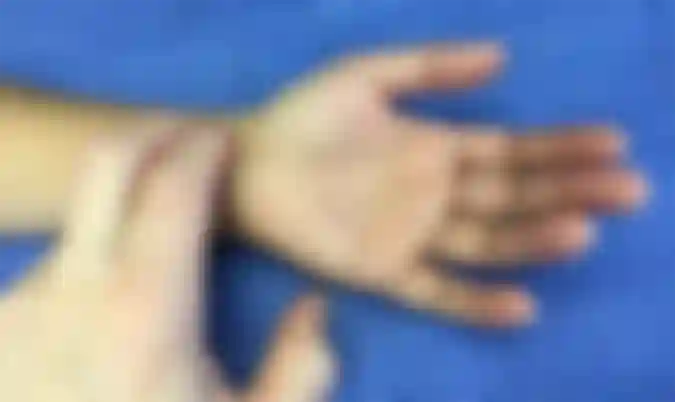one of the medical signs commonly used to know if a patient is alive
PULSE AS ONE OF THE MOST IMPORTANT VITAL SIGNS
Hello to my wonderful Blurt family, hope you doing well?, I hope so. Today I will be discussing about very important vital sign which is the PULSE.
Pulse is one of the vital signs that indicates if a human being is alive. It is the measure of the pressure pulsation in the arteries which is felt when the heart contracts and eject blood in the aorta (the largest artery)
The pulse rate is defined as the number of times the pressure of the ejected blood is felt in wall of arteries per minutes.
The pulse rate is a medical parameter used to indicate that the heart is working and that an organism has life. That is the reason why the pulse rate is also known as heart rate
Taking the pulse is very important because it says a lot about the health of patient. It can be taken either in ordinary or emergency situation to determine state of health of an individual.
One interesting fact about pulse rate is that you don’t have to be an health care provider before you can take pulse rate reading as it is not compulsory to use any medical instrument in reading it
One can simply palpate it by using the fingers to feel the impact of blood in he wall of the arterial blood vessels. Another interesting fact is that pulse rate decreases with increasing age and as such there is an inverse relationship between age and pulse rate.
A newborn infant up to 1 month of age has a pulse rate of 120 to 160 pulse per minute while the adolescence to adult individual has 60 to 100 pulse per minute
There are important medical terms that must be understood as regards pulse rate which are:
Bradycardia and Tachycardia
Bradycardia is a pulse rate which is below or lower than 60 beats/min in adult patient while Tachycardia is a rapid pulse rate which is greater than 100 beats/min in adult patient as well
There are some factors affecting pulse rate which are :
Age, gender, exercise, fever , medication
Age: Like I said earlier, pulse rate decreases with increasing age
Gender: Male’s pulse rate is a little bit lower than the female’s pulse rate
Exercise: Pulse rate normally increases with sympathetic activity such as running, playing football, and sport activities
Fever: As we know that fever usually comes with high body temperature part of which is due to the dilated blood vessels as a result of this blood is easily ejected out of the heart thereby causing an increase in pulse rate
Medications: Some medications increase the heart rate while some reduce it, an example is Desvenlafaxine which increases the heart rate.
Now let us go to the most interesting part which is the site of pulsation in humans
Site of Pulsation
There are about 9 major sites of pulsation in human beings which can be felt or noticed either by using fingers or by simply using a stethoscope and it is very important to note that they are all arteries and not veins
These sites are known to be vitals because if injured or exposed to the outside environment, it should be attended to as fast as possible because such a person could bleed to death, if care is not taken as those areas receive the blood directly from the heart as it pumps the blood out
Those sites include :
1- Carotid artery of the neck
2- Apical beat of the heart (Located at the left side below the breast nipple, it needs Stethoscope for proper hearing)
3- Brachial artery (Located at inner aspect of the elbow)
4- Radial artery (Located at thumb side of the wrist)
5- Femoral artery (Located at the Upper area of the lap close to the groin)
6- Popliteal artery (Located behind the Knee)
7- Posterior Tibialis (found behind the inner part of the ankle)
8- Dorsalis Pedis (found on top of the foot)
9- Temporal artery (Located in the fore-head)


These 9 sites are very dangerous sites in the human body and as such they are referred to as VITALS by health professionals because of the risk involved when injured as the injured patient could bleed to death if proper and fast medical attention is not sought on time
Now let’s use an image to show how to check the pulse of a patient. In this scenario, I will be using the radial artery of the wrist as a case study
The 9 sites listed above can be easily felt just by fingers because those arteries were located close to the surface of the skin at some certain points of the body.


HOW TO CHECK THE RADIAL PULSE OF A PATIENT:
It is done by applying firmly with full attention the tips of your index and middle finger just proximal to the patient’s wrist on the thumb finger side.
If this is done properly, the checker should feel the pressure or beat of the flow of blood in radial artery as the blood is being pumped of the heart, provided the person is still alive.
This approach is among the methods use in emergency situation to determine if a person is alive or not.
Finally, I hope this helps, as you can use this to save the life of an injured victim by easily palpating those those vital sites even without a medical equipment and seek for medical care to avoid hemorrhage.
Thanks for going through my post and stay blessed
Be Safe and Happy Readcasheros


